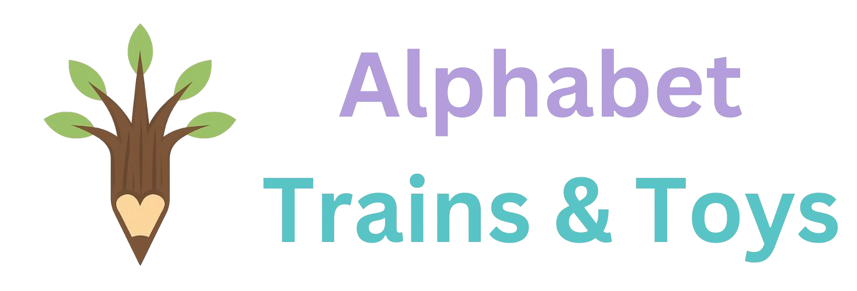- FREE Shipping

Special Price $214.99 Regular Price $244.99
Tummy Time Montessori Shatterproof Mirrors for Kids: Supporting Development Through Reflection
Discover how Tummy time Montessori shatterproof mirrors for kids become powerful tools for cognitive, physical, and emotional development. These specially designed mirrors offer babies and toddlers a fascinating window into self-discovery while providing parents with a safe, educational toy that grows with their child. From encouraging neck strength during tummy time to supporting self-awareness and motor skills, these versatile mirrors have become essential fixtures in developmentally-minded homes and classrooms.
Key Benefits of Developmental Mirrors
Developmental mirrors offer numerous advantages that support your child's growth across multiple domains. Understanding these benefits helps parents make informed choices about incorporating mirrors into their child's play environment.
Recommended: If you’re looking for a safe, developmentally aligned mirror for newborns, our Montessori tummy time mirror for babies is a best-selling choice trusted by Montessori educators and parents alike.
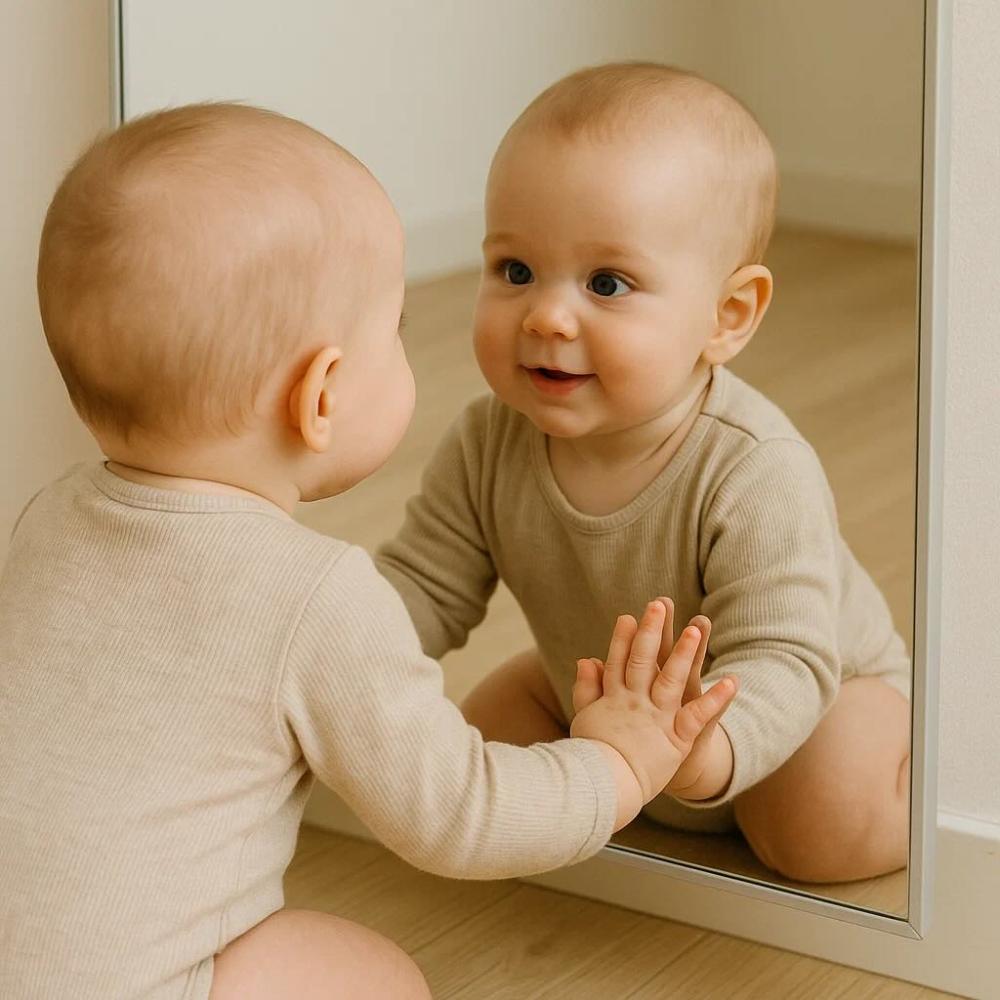
Self-Discovery & Recognition
Mirrors help babies develop self-awareness as they begin to recognize their own reflection. This crucial cognitive milestone typically begins around 6-8 months and continues developing through toddlerhood. Regular mirror play supports this important aspect of identity formation.
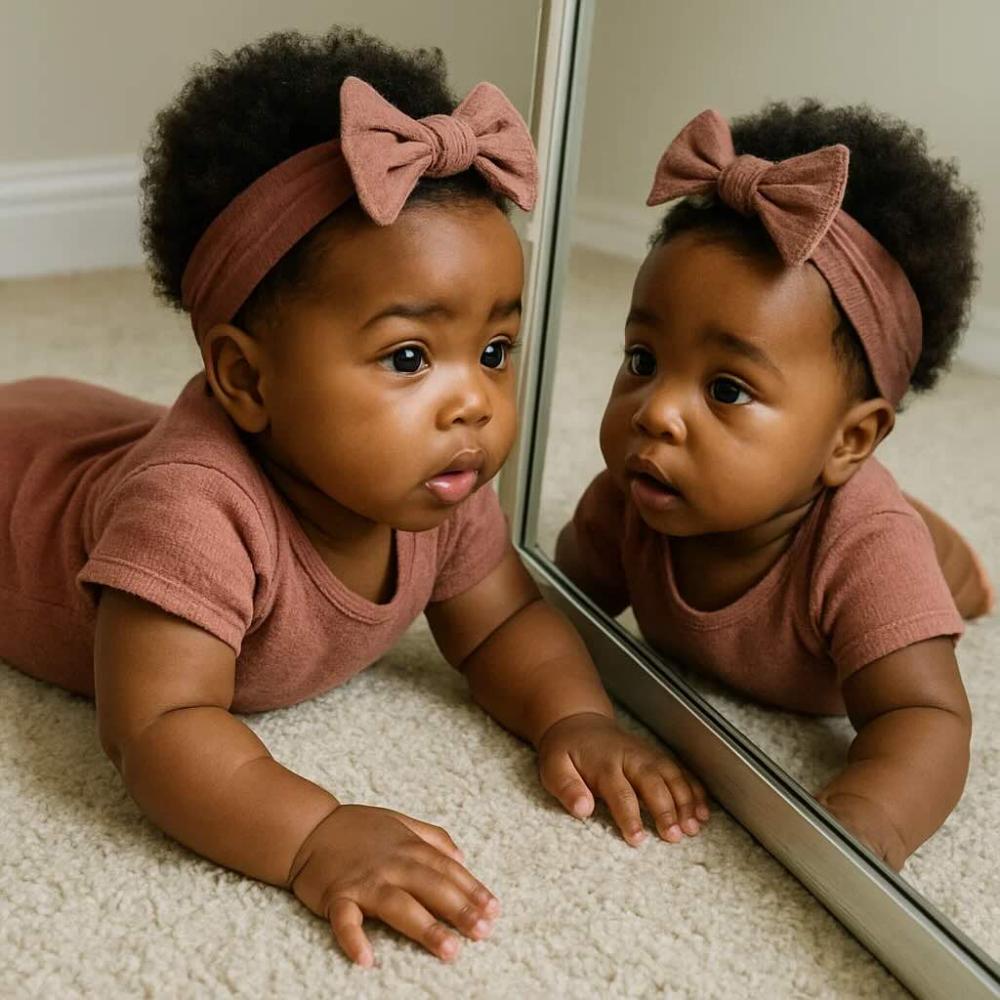
Physical Development
During tummy time, mirrors motivate babies to lift their heads and strengthen neck muscles. The fascinating reflection encourages longer periods of engagement, helping develop core strength. For older babies, mirrors support pulling up, cruising, and other motor skill development.

Sensory Exploration
Mirrors provide rich visual stimulation that captivates babies' attention. The high-contrast reflection helps develop visual tracking skills and depth perception. As children grow, mirrors become tools for exploring facial expressions, emotions, and movement in an engaging sensory experience.
Did you know? Most babies begin recognizing themselves in the mirror between 6–8 months. Daily mirror play during tummy time can spark that moment of self-discovery sooner.
Safety Features: Why Shatterproof Matters
When selecting mirrors for young children, safety must be the top priority. Tummy time Montessori shatterproof mirrors for kids are specifically designed with these concerns in mind, offering peace of mind for parents while providing developmental benefits.
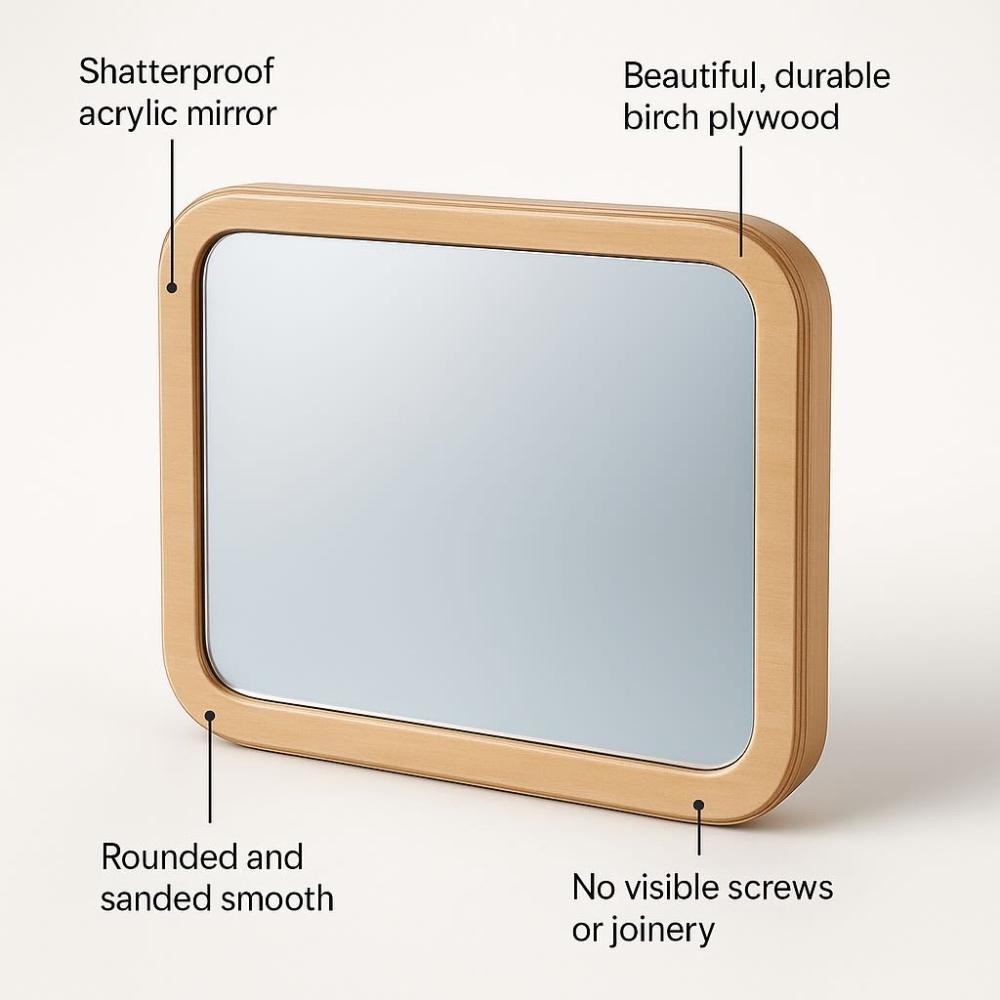
Essential Safety Features
- Shatterproof acrylic mirror surface that won't break into dangerous shards
- Rounded edges and corners to prevent injuries during active play
- Non-toxic, child-safe materials and finishes free from harmful chemicals
- Stable design that prevents tipping for floor-standing models
- Secure mounting hardware for wall-mounted versions
- Compliance with safety standards including ASTM and CPSC certifications
Materials Matter
Most high-quality developmental mirrors use acrylic or polycarbonate rather than glass. These materials provide a clear reflection while eliminating the risk of dangerous breakage. Look for mirrors with solid wooden frames made from sustainably sourced materials with non-toxic finishes.
Safety Tip: Always supervise young children during mirror play, especially with portable mirrors. For wall-mounted options, ensure proper installation using appropriate anchors for your wall type.
Types of Developmental Mirrors
Developmental mirrors come in various designs to suit different ages, spaces, and purposes. Understanding the options helps you select the perfect mirror for your child's current stage and growing needs.
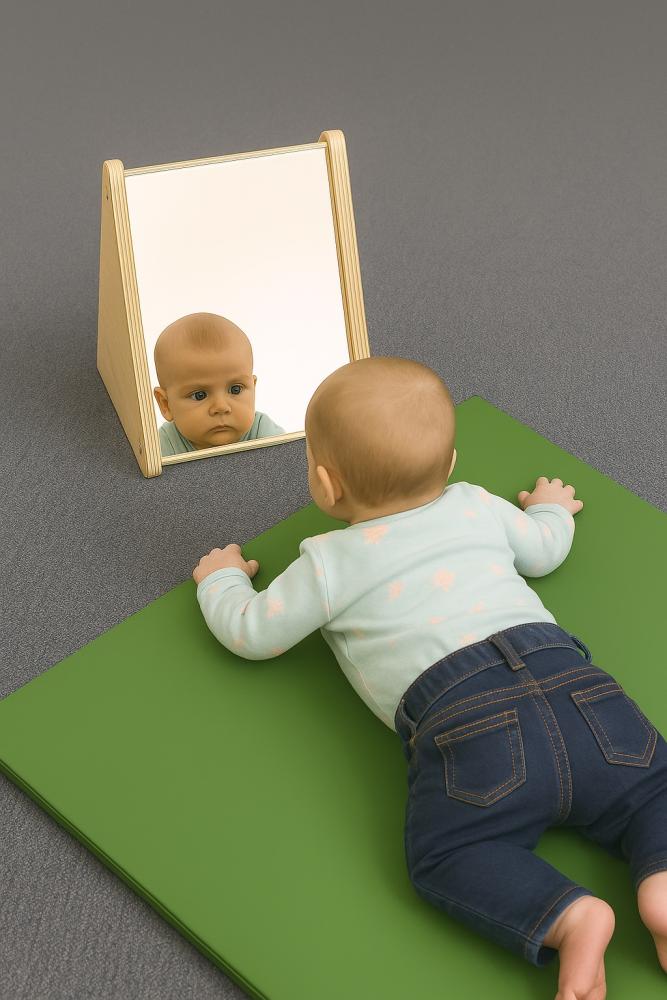
Tummy Time Mirrors
Know Thyself — even before you can crawl. Our tummy time mirrors are shatterproof, baby-safe, and built to support early self-recognition, visual tracking, and motor development. Our tummy time mirrors:
- Made with safe, shatterproof acrylic to encourage early self-recognition
- Crafted from durable 15mm birch plywood with a non-toxic UV finish that won’t yellow over time
- Designed with smooth, rounded edges and no exposed hardware for infant safety
- Versatile — can be used horizontally or vertically as your baby grows
- GreenGuard™ Gold certified, antimicrobial, and proudly made in the USA with a lifetime warranty
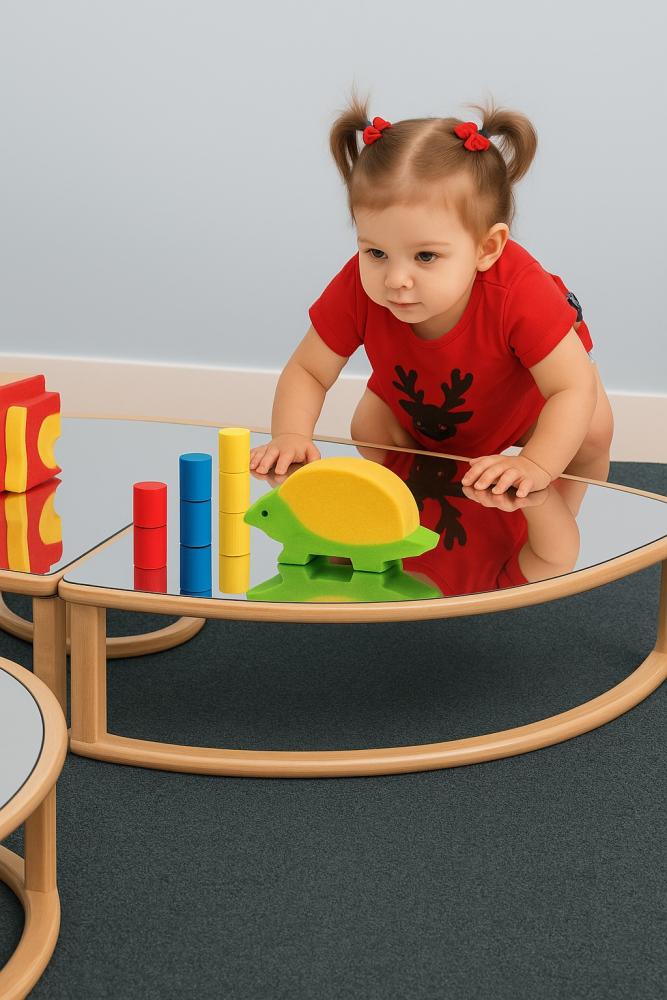
Toddler Floor Mirrors
See the floor, explore some more. Reflection meets movement — floor mirrors designed to support your baby’s earliest milestones with safety, style, and Montessori-aligned purpose. Key features include:
- Shatterproof acrylic mirrors provide safe self-recognition and sensory exploration
- Rounded birch plywood frames with no visible screws or joinery for maximum safety
- Encourages gross motor development through reaching, rolling, and crawling
- Promotes self-awareness, confidence, and independent movement
- Made in the USA with GREENGUARD™ Gold certification and antimicrobial finish
- Ideal for 6-24 months as babies gain sitting skills

Shatterproof Wall-Mounted Mirrors
Mirror, mirror on the wall...Who’s growing confident, curious, and tall? Best-selling shatterproof wall mirrors designed to foster self-awareness and emotional development in early learners. Our U.S. made shatterproof mirros:
- Encourage self-recognition, curiosity, and cognitive growth
- Made from safe, shatterproof acrylic for daily classroom use
- Rounded edges and corners for added safety
- Easy wall-mount installation with included hardware
- Available in multiple sizes
Tip: Not sure which mirror suits your baby’s age? Scroll to the guide below for personalized recommendations by developmental stage.
Age-Appropriate Mirror Selection Guide
Choosing the right mirror for your child's developmental stage ensures they receive maximum benefit. This guide helps match mirror features with your child's growing abilities.
| Age Range | Developmental Stage | Recommended Mirror Type | Key Features to Look For |
| 0-3 months | Limited head control, visual development | Portable tummy time mirror | High-contrast edges, lightweight, easy to position at eye level |
| 3-6 months | Improving head control, beginning to sit with support | Portable or small floor mirror | Stable base, angled reflection, sensory elements |
| 6-12 months | Sitting independently, crawling, pulling up | Floor-standing or wall-mounted | Larger reflection area, sturdy construction, pull-up bar option |
| 12-24 months | Standing, cruising, walking | Wall-mounted with pull-up bar | Full-length reflection, secure mounting, horizontal bar |
| 2-3 years | Independent movement, self-awareness, pretend play | Wall-mounted full-length | Child-height installation, durable construction, dress-up area integration |
Montessori-Inspired Mirror Usage Tips
Maximize the developmental benefits of your child's mirror with these Montessori-inspired approaches. These practical tips help create meaningful experiences that support your child's natural curiosity and development.
Optimal Positioning
- Tummy Time Placement: Position portable mirrors at eye level, approximately 8-12 inches from your baby's face for optimal viewing.
- Floor Mirror Angle: Set floor-standing mirrors at a 10-15 degree angle to provide the clearest reflection for sitting babies.
- Wall-Mounted Height: Install wall mirrors with the bottom edge at floor level for crawling babies, or 12-18 inches up for standing toddlers.
- Pull-Up Bar Position: Mount bars at your child's chest height when standing to encourage proper pulling up technique.
Engagement Activities
- Narrated Reflection: Sit with your baby and gently describe what you both see in the mirror, building language skills.
- Movement Games: Encourage reaching, kicking, and other movements while watching the reflection.
- Facial Expressions: Make different expressions for your baby to observe, supporting emotional recognition.
- Object Exploration: Show how objects appear in the mirror compared to real life, building cognitive understanding.
- Self-Care Practice: For toddlers, use mirrors during grooming routines to build independence.
Montessori Principle: Allow your child to explore the mirror at their own pace without interruption. Observation without interference supports concentration and self-discovery.
Frequently Asked Questions
Are acrylic mirrors safe for babies?
Yes, high-quality acrylic mirrors are specifically designed to be baby-safe. Unlike glass mirrors, acrylic mirrors won't shatter into dangerous shards if broken. Look for mirrors labeled as "shatterproof" or "baby-safe" and check for rounded edges and non-toxic materials. Always supervise young children during mirror play.
At what age should I introduce a mirror during tummy time?
You can introduce a mirror during tummy time from birth. Even newborns benefit from the visual stimulation, though they won't recognize themselves until around 6-8 months. Start with short sessions of 1-2 minutes and gradually increase as your baby builds strength and interest.
How do I clean and maintain a baby-safe mirror?
Clean acrylic mirrors with a soft, damp microfiber cloth and mild soap if needed. Avoid ammonia-based cleaners, alcohol, or abrasive materials that can damage the surface. For wooden frames, use a slightly damp cloth and dry immediately. Regular cleaning helps maintain clarity and hygiene.
What's the difference between regular mirrors and Montessori mirrors?
Montessori mirrors are specifically designed with child development in mind. They feature shatterproof materials, child-appropriate mounting heights, and often include elements like pull-up bars to support motor development. They're positioned to give children an accurate, undistorted view of themselves, supporting self-discovery and independence.
Supporting Your Child's Journey of Self-Discovery
Tummy time Montessori shatterproof mirrors for kids offer a unique window into your child's developing sense of self. From those first precious moments of tummy time to the exciting milestones of standing and walking, these specially designed mirrors provide safe, engaging opportunities for growth and discovery.
By selecting age-appropriate mirrors with proper safety features, you're investing in a versatile developmental tool that will grow with your child through multiple stages. The benefits extend beyond physical development to include cognitive understanding, emotional recognition, and the building blocks of independence that form the foundation of the Montessori approach.
 “The child who has never observed himself in a mirror is a child who has missed the first step in self-awareness.”
“The child who has never observed himself in a mirror is a child who has missed the first step in self-awareness.” 
